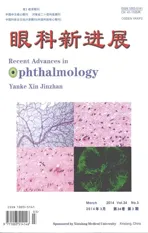腺相关病毒载体用于外伤性视神经损伤基因治疗的研究进展△
2014-03-08吴国玖查旭张远平曹霞马林昆
吴国玖 查旭 张远平 曹霞 马林昆
视神经是由视网膜神经节细胞(retinal ganglion cells,RGC)的轴突在巩膜筛孔处汇聚向后延伸形成。外伤性视神经损伤(traumatic optic nerve injury,TONI)常导致严重视力下降或盲,以往多种药物及手术治疗也难见成效。2001年 Acland等[1]用重组腺相关病毒(recombination adeno-associated virus,rAAV)载体编码RPE65可使先天性利伯氏黑蒙病狗恢复视觉功能,从此激发人们对转基因治疗视神经疾病的极大兴趣。基因治疗通常是通过载体将目的基因即治疗基因导入靶细胞,通过表达产物从而达到治疗目的。已证实腺相关病毒(adeno-associated virus vector,AAV)载体具有转染效率高、免疫原性低、无毒性、长期稳定表达等优点[2],是目前最常用的转基因治疗载体。TONI基因治疗最常用的研究模型是哺乳动物视神经横断或挤压伤,与临床的视神经外伤相似。本文就近年来关于视神经损伤后微环境变化及应用AAV载体基因治疗TONI的研究进展进行综述。
1 视神经损伤与RGC凋亡
1.1 视神经损伤后微环境变化 视神经损伤后,神经结构和周边微环境遭到破坏,细胞轴突离断、水肿、死亡,同时也出现一些不利因素,如自由基形成、RGC 内超氧化物增加[3]、过氧化物阴离子增加[4]、谷氨酸盐的毒性作用、K+门控通道 KV1家族出现[5]、caspase-6 及 caspase-8 上 调[6]、caspase-2 激活[7]、JNK 信号通路激活[8]、轴突残端有毒物质渗漏、硫苷脂增加[9]等,这些因素均不利于视神经修复。同时,视神经损伤后因自身固有的修复能力会产生一些有利视神经修复的因素,如自我吞噬功能上调以保护神经元存活[10]、再生RGC中上调的晶状体蛋白β2通过增强睫状神经营养因子的产生而促进轴突再生[11]、睫状神经营养因子在星型胶质细胞的显著表达[12]和胸腺素-β4 上调[13]均增强 RGC 存活和促进轴突再生等,此外尚有许多不为所知的影响因素有待发现。
1.2 RGC死亡、凋亡特点 视神经损伤后周边微环境变得不稳定使RGC渐渐死亡。成年哺乳动物视神经损伤存在延时现象,即视神经损伤后3 d才能发现RGC死亡,RGC程序性死亡相关改变可能在伤后6 h已经开始[14],RGC死亡高峰在视神经损伤后5~9 d,在损伤 2周后有 10%~15%的 RGC存活[15]。凋亡是一种继发性死亡形式,RGC凋亡高峰出现在伤后3个月[16],直至伤后6个月仍可见RGC凋亡[17]。因此,视神经损伤后及时增强RGC生存能力和促进其轴突再生是治疗的关键。
2 AAV载体
2.1 AAV载体生物学特点 野生型 AAV属于微小病毒科,是依赖病毒类的一种。AAV为无包膜单链DNA,外有衣壳蛋白包裹,是动物病毒中最小的病毒[18]。AAV载体基因组长约4.6 kb,包括2个开放阅读框—rep和cap,两端各有一个末端反向重复序列(inverted terminal repeat,ITR),在保留 ITR 的前提下,AAV载体的rep及cap基因由外源性基因表达框替代,经修饰后形成 rAAV载体。自身互补型rAAV 载体(self-complementary rAAV,ScrAAV)也是在AAV载体的基础上改良而成,rAAV载体和ScrAAV载体一个共同点是两者都含双链基因组。
2.2 AAV载体的血清型及其在眼部转染特点 目前,来自人的 AAV载体血清型有 12种[19],包括AAV1-AAV9、avianAAV、bovineAAV 和 canineAAV等,不同血清型AAV载体对不同细胞或组织的转染效率不同。其中,AAV2和AAV5载体最常用于治疗眼部疾病,AAV2载体具有亲神经性、优先转染神经元、能有效转染RGC[20]、表达持久等优点。而 AAV5载体主要转染光感受器和视网膜色素上皮细胞。其中rAAV2的杂合载体 rAAV2/2和rAAV2/6转染RGC的效率最高[21]。但 AAV载体也存在不足,如携带基因小于5 kb、滴度低和表达“滞后性”,即被转染细胞重组AAV-DNA转变为转录活跃的双链模式需要一定时间。改良型ScAAV载体含有双链基因组,具有更快启动转基因表达和更高转染效率等特点[22-23],这或许会弥补AAV载体表达“滞后性”这一不足。
3 利用AAV载体基因治疗TONI
3.1 AAV载体转导营养因子对RGC的保护作用
目前用于治疗视神经损伤的营养因子主要有睫状神经营养因子(ciliary neurotrophic factor,CNTF)、脑源性神经营养因子(brain-derived neurotrophic factor,BDNF)、血管内皮生长因子(vascular endothelial growth factor,VEGF)、血小板源性生长因子 CC(platelet-derived growth factor CC,PDGF-CC)等。实验证实,玻璃体注射BDNF和VEGF能增强RGC存活,而对轴突再生无明显促进作用[24-25]。D’Onofrio等[25]向成年大鼠玻璃体内注射 AAV-VEGF-ZFP(锌指蛋白),可使RGC的存活数量提高2倍,ZFP的作用在于上调 VEGF-A,进一步促进 RGC存活。相似地,PDGF-CC也主要体现在增强RGC存活方面[26],PDGF-CC通过调节糖原合成酶激酶-3β的磷酸化和表达对RGC起保护作用,同时也调节一些凋亡相关和神经保护基因的表达。Hellström等[27]将环腺苷酸类似物(CTP-cAMP)联合 rAAV2-CNTF-GFP注射到成年大鼠玻璃体内,证实CNTF可以增强RGC存活和促进轴突再生,但在此基础上,CTP-cAMP并没有进一步的促进作用。但后来 Hellström等[28]行鼠玻璃体内注射 CTP-cAMP和 rAAV2-CNTF-GFP、rCNTF治疗,结果发现约1/3RGC存活,其中27%的RGC轴突再生。这是一种基因联合药物治疗方法,实验注药时间几乎与视神经破坏手术同时进行,并提出rCNTF对于急性视神经损伤有潜在的治疗意义。以上实验证明,CNTF能增强RGC存活和促进轴突再生,正常情况下,CNTF主要存在于星型胶质细胞内,神经受损后,CNTF在Müller细胞也有表达。
3.2 敲除 SOCS3、PTEN和 ephrinB3基因对视神经修复的促进作用 机体组织破坏后,通常进入积极的修复状态,但是以往一直认为视神经损伤后不可修复,损伤的神经元内是否存在抑制修复的基因?Smith等[29]把 AAV-cre(重组酶)注射到成年小鼠玻璃体内,即利用AAV载体表达cre以敲除SOCS3基因,与没有敲除 SOCS3组相比,AAV-cre组 RGC表现出显著的再生能力,再向AAV-cre组玻璃体内注入CNTF,能进一步加强 RGC轴突再生。后来,Hellström 等[27]从正面证实 SOCS3对视神经修复的抑制作用,他们把rAAV2-SOCS3-GFP注射到成年大鼠玻璃体内,使 RGC过度表达 SOCS3,结果导致RGC轴突几乎完全不能再生,同时也提出AAV2转导CNTF表达比玻璃体内直接注射rCNTF治疗更有效。
视神经损伤的修复不完全等同于RGC轴突的再生,还包括再生轴突能否进入大脑,经过视交叉,到达相应靶区,并恢复视功能。2010年 Kurimoto等[30]提出敲除鼠 RGC内 PETN基因有利于细胞轴突再生,时隔2 a,他们再次进行了相似的实验[31],他们向成年小鼠眼内注射AAV2-cre,以敲除PETN,2周后建立视神经横切外伤模型,同时眼内注射酵母多糖(Zymosan)及 CPT-cAMP,以霍乱毒素 B(CTB)示踪再生轴突,实验反复向玻璃体内注射Zymosan及CPT-cAMP,10周后发现36%RGC存活,12周后大量视神经全长呈CTB阳性,即视神经全长再生,大部分再生轴突到达视交叉上核,而仅注射AAV2-GFP、Zymosan及 CPT-cAMP组10周 RGC存活率为16%,视神经CTB阳性很少。该实验证明了视神经损伤后视觉中央回路重建及部分视力恢复的可行性,实验中Zymosan主要作用是造成轻微持续的眼内炎症反应,并促使一些炎性细胞如巨噬细胞分泌生长因子和癌调蛋白,CPT-cAMP与酵母多糖共同促进癌调蛋白与RGC捆绑以提高细胞再生[30],这种轻微足量的连续炎症刺激可以使轴突细胞再生并到达视神经的全长。对于这一类似问题,目前尚有争议,有研究者[32]认为癌调蛋白水平在玻璃体内注射Zymosan后并没有明显增加,并推断巨噬细胞源性癌调蛋白不可能是介导由眼内炎症引起这种有益作用的主要因素,而一定是另一机制所启动,同时也提出,癌调蛋白的作用与细胞内cAMP水平上升密切相关。cAMP是调节神经元存活和神经轴突再生至关重要的第二信使,辅助促进轴突再生,CPT-cAMP的浓度也是实验成功的要素之一。此外,Duffy等[33]发现,敲除小鼠 ephrinB3基因,可在视神经损伤点外1000 μm发现再生轴突,明显促进轴突再生,并认为ephrinB3是轴突生长重要的鞘磷脂相关的生理抑制因子。
4 总结
本文综述了神经损伤后周围微环境的改变以及利用AAV载体基因治疗TONI的相关进展,表明视神经损伤后微环境变化的复杂性,显示AAV载体在视神经损伤基因治疗中强大的应用潜能,同时也启示我们视神经损伤基因治疗会是一种更有效的治疗方法。目前AAV载体携带基因容量小等问题尚未得到有效解决,而且基因治疗过程复杂,涉及从胞外到胞核及转染表达等一系列步骤,其间可能发生AAV颗粒降解,或因缺乏对靶细胞的专一性而转染其他组织,或不能在特定组织大量有效的转染等,都是有待解决的问题。另外,目前多数实验采用成年鼠视神经外伤为模型,然而有研究表明:鼠RGC固有生存能力受其年龄影响[34],外伤后RGC死亡和再生能力受到 RGC发育形成时间先后的影响[35],最后,在正常视网膜和病变视网膜中,AAV载体介导转染能力也是不同的[36]。总之,影响基因治疗疗效的因素远不止这些,相信随着分子生物学、细胞生物学的发展,神经细胞死亡、轴突再生机制的进一步阐明,会有更佳的改良型AAV载体应用于临床。
1 Acland GM,Aguirre GD,Ray J,Zhang Q,Aleman TS,Cideciyan AV,et al.Gene therapy restores vision in a canine model of childhood bl indnes[J].Nat Genet,2001,28(1):92-95.
2 Stieger K,Schroeder J,Provost N,Mendes-Madeira A,Belbellaa B,Le Meur G,et al.Detection of intact rAAV particles up to 6 years after successful gene transfer in the retina of dogs and primates[J].Mol T-her,2009,17(3):516-523.
3 Kanamori A,Catrinescu MM,Kanamori N,Mears KA,Beaubien R,Levin LA.Superoxide is an associated signal for apoptosis in axonal injury[J].Brain,2010,133(9):2612-2625.
4 Catrinescu MM,Chan W,Mahammed A,Gross Z,Levin LA.Superoxide signaling and cell death in retinal ganglion cell axotomy:Effects of metallocorroles[J].Exp Eye Res,2012,97(1):31-35.
5 Koeberle PD,Wang Y,Schlichter LC.Kv1.1 and Kv1.3 channels contribute to the degeneration of retinal ganglion cells after optic nerve transection in vivo[J].Cell Death Differ,2010,17(1):134-144.
6 Monnier PP,D’Onofrio PM,Magharious M,Hollander AC,Tassew N,Szydlowska K,et al.Involvement of caspase-6 and caspase-8 in neuronal apoptosis and the regenerative failure of injured retinal ganglion cells[J].J Neurosci,2011,31(29):10494-10505.
7 Ahmed Z,Kalinski H,Berry M,Almasieh M,Ashush H,Slager N,et al.Ocular neuroprotection by siRNA targeting caspase-2[J].Cell Death Dis,2011,16(2):e173.
8 Fernandes KA,Harder JM,Fornarola LB,Freeman RS,Clark AF,Pang IH,et al.JNK2 and JNK3 are major regulators of axonal injury-induced retinal ganglion cell death[J].Neurobiol Dis,2012,46(2):393-401.
9 Winzeler AM,Mandemakers WJ,Sun MZ,Stafford M,Phillips CT,Barres BA.The lipid sulfatide is a novel myelin-associated inhibitor of CNS axon outgrowth[J].J Neurosci,2011,31(17):6481-6492.
10 Rodríguez-Muela N,Boya P.Axonal damage,autophagy and neuronal survival[J].Autophagy,2012,8(2):286-288.
11 Thanos S,Böhm MR,Schallenberg M,Oellers P.Traumatology of the optic nerve and contribution of crystallins to axonal regeneration[J].Cell Tissue Res,2012,349(1):49-69.
12 Leibinger M,Müller A,Andreadaki A,Hauk TG,Kirsch M,Fischer D.Neuroprotective and axon growth-promoting effects following inflammatory stimulation on mature retinal ganglion cells in mice depend on ciliary neurotrophic factor and leukemia inhibitory factor[J].J Neurosci,2009,29(45):14334-14341.
13 Magharious M,D’Onofrio PM,Hollander A,Zhu P,Chen J,Koeberle PD.Quantitative iTRAQ analysis of retinal ganglion cell degeneration after optic nerve crush[J].J Proteome Res,2011,10(8):3344-3362.
14 Lukas TJ,Wang AL,Yuan M,Neufeld AH.Early cellular signaling responses to axonal injury[J].Cell Commun Signal,2009,13:5.
15 Nadal-Nicolás FM,Jiménez-López M,Sobrado-Calvo P,Nieto-López L,Cánovas-Martínez I,Salinas-Navarro M,et al.Brn3a as a marker of retinal ganglion cells:Qualitative and quantitative time course studies in naive and optic nerve injured retinas[J].Invest Ophthalmol Vis Sci,2009,50(8):3860-3868.
16 Levkovitch-Verbin H,Dardik R,Vander S,Melamed S.Mechanism of retinal ganglion cells death in secondary degeneration of the optic nerve[J].Exp Eye Res,2010,91(2):127-134.
17 Vander S,Levkovitch-Verbin H.Regulation of cell death and survival pathways in secondary degeneration of the optic nerve-a long-term study[J].Curr Eye Res,2012,37(8):740-748.
18 Goncalves MA.Adeno-associated virus:from defective virus to effective vector[J].Virol J,2005,6(2):43-59.
19 Daya S,Berns KI.Gene therapy using adeno-associated virus vectors[J].Clin Microbiol Rev,2008,21(4):583-593.
20 Kolstad KD,Dalkara D,Guerin K,Visel M,Hoffmann N,Schaffer DV,et al.Changes in adeno-associated virus-mediated gene delivery in retinal degeneration.changes in adeno-associated virus-mediated gene delivery in retinal degeneration[J].Hum Gene Ther,2010,21(5):571-578.
21 Hellström M,Ruitenberg MJ,Pollett MA,Ehlert EM,Twisk J,Verhaagen J,et al.Cellular tropism and transduction properties of seven adeno-associated viral vector serotypes in adult retina after intravitreal injection[J].Gene Ther,2009,16(4):521-532.
22 Natkunarajah M,Trittibach P,McIntosh J,Duran Y,Barker SE,Smith AJ,et al.Assessment of ocular transduction using single-stranded and self-complementary recombinant adeno-associated virus serotype 2/8[J].Gene Ther,2008,15(6):463-467.
23 Kong F,Li W,Li X,Zheng Q,Dai X,Zhou X,et al.Self-complementary AAV5 vector facilitates quicker transgene expression in photoreceptor and retinal pigment epithelial cells of normal mouse[J].Exp Eye Res,2010,90(5):546-554.
24 Hellström M,Harvey AR.Retinal ganglion cell gene therapy and visual system repair[J].Curr Gene Ther,2011,11(2):116-131.
25 D’Onofrio PM,Thayapararajah M,Lysko MD,Magharious M,Spratt SK,Lee G,et al.Gene therapy for traumatic central nervous system injury and stroke using an engineered zinc finger protein that upregulatesVEGF-A[J].J Neurotrauma,2011,28(9):1863-1879.
26 Tang Z,Arjunan P,Lee C,Li Y,Kumar A,Hou X,et al.Survival effect of PDGF-CC rescues neurons from apoptosis in both brain and retina by regulating GSK3beta phosphorylation[J].J Exp Med,2010,207(4):867-880.
27 Hellström M,Muhling J,Ehlert EM,Verhaagen J,Pollett MA,Hu Y,et al.Negative impact of rAAV2 mediated expression of SOCS3 on the regeneration of adult retinal ganglion cell axons[J].Mol Cell Neurosci,2011,46(2):507-515.
28 Hellström M,Pollett MA,Harvey AR.Post-injury delivery of rAAV2-CNTF combined with short-term pharmacotherapy is neuroprotective and promotes extensive axonal regeneration after optic nerve trauma[J].J Neurotrauma,2011,28(12):2475-2483.
29 Smith PD,Sun F,Park KK,Cai B,Wang C,Kuwako K,et al.SOCS3 deletion promotes optic nerve regeneration in vivo[J].Neuron,2009,64(5):617-623.
30 Kurimoto T,Yin Y,Omura K,Gilbert HY,Kim D,Cen LP,et al.Longdistance axon regeneration in the mature optic nerve:contributions of oncomodulin,cAMP,and pten gene deletion[J].J Neurosci,2010,30(46):15654-15663.
31 de Lima S,Koriyama Y,Kurimoto T,Oliveira JT,Yin Y,Li Y,et al.Full-length axon regeneration in the adult mouse optic nerve and partial recovery of simple visual behaviors[J].Proc Natl Acad Sci U S A,2012,109(23):9149-9154.
32 Hauk TG,Müller A,Lee J,Schwendener R,Fischer D.Neuroprotective and axon growth promoting effects of intraocular inflammation do not depend on oncomodulin or the presence of large numbers of activated macrophages[J].Exp Neurol,2008,209(2):469-482.
33 Duffy P,Wang X,Siegel CS,Tu N,Henkemeyer M,Cafferty WB,et al.Myelin-derived ephrinB3 restricts axonal regeneration and recovery after adult CNS injury[J].Proc Natl Acad Sci U S A,2012,109(13):5063-5068.
34 Luo JM,Geng YQ,Zhi Y,Zhang MZ,van Rooijen N,Cui Q.Increased intrinsic neuronal vulnerability and decreased beneficial reaction of macrophages on axonal regeneration in aged rats[J].Neurobiol Aging,2010,31(6):1003-1009.
35 Dallimore EJ,Park KK,Pollett MA,Taylor JS,Harvey AR.The life,death and regenerative ability of immature and mature rat retinal ganglion cells are influenced by their birthdate[J].Exp Neurol,2010,225(2):353-365.
36 Kolstad KD,Dalkara D,Guerin K,Visel M,Hoffmann N,Schaffer DV,et al.Changes in adeno-associated virus-mediated gene delivery in retinal degeneration[J].Hum Gene Ther,2010,21(5):571-578.
